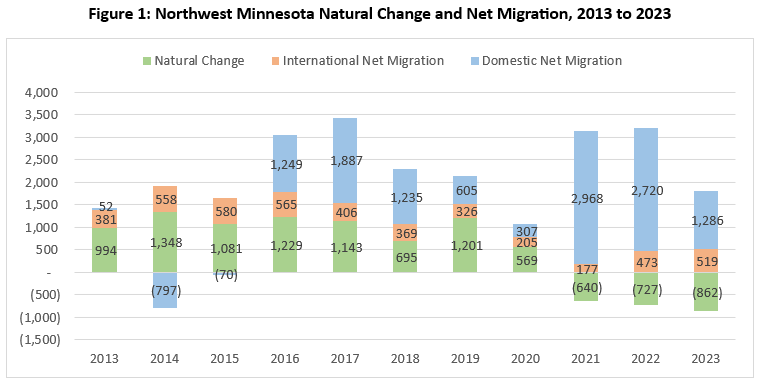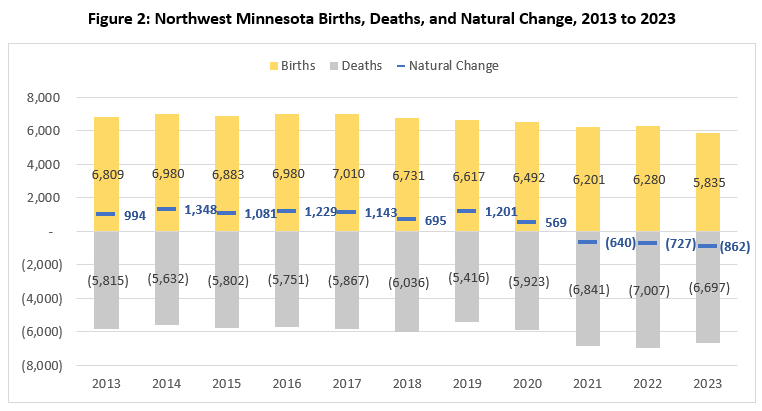 The presence of such industry powerhouses as Polaris, Arctic Cat and New Flyer make Northwest Minnesota a hub of transportation equipment manufacturing.
The presence of such industry powerhouses as Polaris, Arctic Cat and New Flyer make Northwest Minnesota a hub of transportation equipment manufacturing.
From wheat and potatoes to soybeans and sugar beets, the region is a major producer and processor of food staples and specialty agricultural products.
Want the freshest data delivered by email? Subscribe to our regional newsletters.
10/21/2024 3:00:38 PM
Anthony Schaffhauser
From 2020 to 2023, Northwest Minnesota's population grew by more than 5,900 people, or 1%. All this growth is attributable to more people moving into the region than moving out— positive net migration. Increased net migration to rural counties has been a trend in Minnesota statewide, as well as nationally. According to the USDA Economic Research Service, "f ear of exposure to COVID-19 in metro areas and the subsequent increase in remote work contributed to a major shift in migration patterns."
People moving for quality-of-life factors, so called "amenity migration," has been long recognized as a draw to rural areas. Natural beauty and outdoor recreation of lakes, forests and prairielands in Northwest Minnesota have drawn retirees, and now remote work i allows for more locational freedom. According to a 2021 survey done by Paulsen, a marketing agency based in South Dakota, 66% of Americans would consider moving to a rural home or a subdivision if telecommuting was an option. More land and space around a home, house affordability, general lower cost of living, fewer people, less traffic and a safe environment with clean air and water are some reasons cited by survey respondents for moving to a rural area.
In-migration plays a prominent role in Northwest Minnesota's recent population growth (see Figure 1). Net migration from moves made within the U. S., called domestic net migration, are separate from the net migration from moves made to and from the U.S. and foreign countries, called international net migration. Domestic net migration surged to the highest and second highest levels of the decade in 2021 and 2022, with 2017 being the only year that exceeded the level in 2023.

Since Northwest Minnesota's natural rate of increase— the comparison of births and deaths — has slowed and even turned negative in the last three years, in-migration has become even more important. Negative natural change has only recently been occurring in Northwest Minnesota. Prior to 2021, positive natural change was the norm. Birth have been generally trending down since 2016, while a higher number of deaths occurred in 2021 and 2022 (see Figure 2).
While deaths decreased in 2023, they are still higher than any year from 2013 through 2020. Thus, the switch to negative natural increase is from a combination of fewer births and more deaths, but more so from the increase in deaths. In 2023, there were 657 fewer births and 774 more deaths than in 2020. In fact, there were about 2,200 more deaths than births in Northwest Minnesota for a negative natural increase, while the gain from net migration was about 8,100. Northwest Minnesota's positive net migration overwhelmingly surmounted the negative natural change.

A key question about amenity migration is how much it impacts the workforce. If nearly all the net migration is retirees, then there would be little impact. Table 1 estimates the number of people under age 65 moving into the region using the population estimates by age over three years from 2020 to 2023. If there is an increase in the number of people three years older from three years in the past, this is from net migration because there is no other cause for the number to increase. Granted, it slightly understates net migration because there is some decrease from deaths, but death rates are very low for ages under 65 years. According to the National Institutes of Health, the 2018 to 2022 death rate for Minnesotans aged 40 to 64 was 0.3%, and 0.1% for aged 20 to 39.
| Table 1: Northwest Minnesota 2020 to 2023 Net Migration Estimates for Age Groups Under 65 Years | |||||
|---|---|---|---|---|---|
| Age in 2020 | 2020 Population | Age in 2023 | 2023 Population | 2020 -2023 Change | |
| Number | Percent | ||||
| -3 to 11* | 105,502 | 0 to 14 | 107,639 | 2,137 | 2.0% |
| 12 to 21 | 75,077 | 15 to 24 | 72,925 | -2,152 | -2.9% |
| 22 to 51 | 190,549 | 25 to 54 | 192,731 | 2,182 | 1.1% |
| 52 to 61 | 77,185 | 55 to 64 | 78,938 | 1,753 | 2.3% |
| Up to 61 | 448,313 | 0 to 64 | 452,233 | 3,920 | 0.9% |
| * Includes births in 2021 to 2023 | |||||
| Source: U.S. Census Bureau, Population Estimates | |||||
The estimated cumulative net migration of those under age 65 is 3,920 (see Table 1). The total net migration for all age groups is 8,143 (see Figure 1). Thus, about half (52%) of the net migration is in the traditional retirement age of 65 and over. With 2,137 net migrants under age 15 in 2023, that leaves around 1,783 in the 15 to 64 age group, or 22%. However, there were 2,182 net migrants aged 25 to 54, while there was a net loss of 2,152 from those aged 15 to 24 moving away.
That is a net benefit to the Northwest region's workforce, because the labor force participation rate (LFPR) is the highest among those aged 25 to 54 years. According to the U.S. Census Bureau's 2018 to 2022 American Community Survey 5-year estimates, the 25- to 54- year- old LFPR was 87%, compared to 71% for 16- to 24- year- olds and 69% for people aged 55 to 64. Thus, even with only a bit over 20% of the net migration in the traditional working age group, it is still providing a substantial boost to the region's labor force.
While a significant portion of the workers that moved to Northwest Minnesota are no doubt working remotely for employers outside the region, we can assume that the bulk of their wages are spent in the region, thereby increasing regional prosperity. Likewise for retirees that move to Northwest Minnesota; even if they aren't participating in the labor force, they're still contributing to the economy. Furthermore, many of the partners and family members of remote workers and retirees will work for employers in the region. Clearly this recent trend of increased net migration is a great benefit to the region.
Contact Anthony Schaffhauser at Anthony.schaffhauser@state.mn.us.